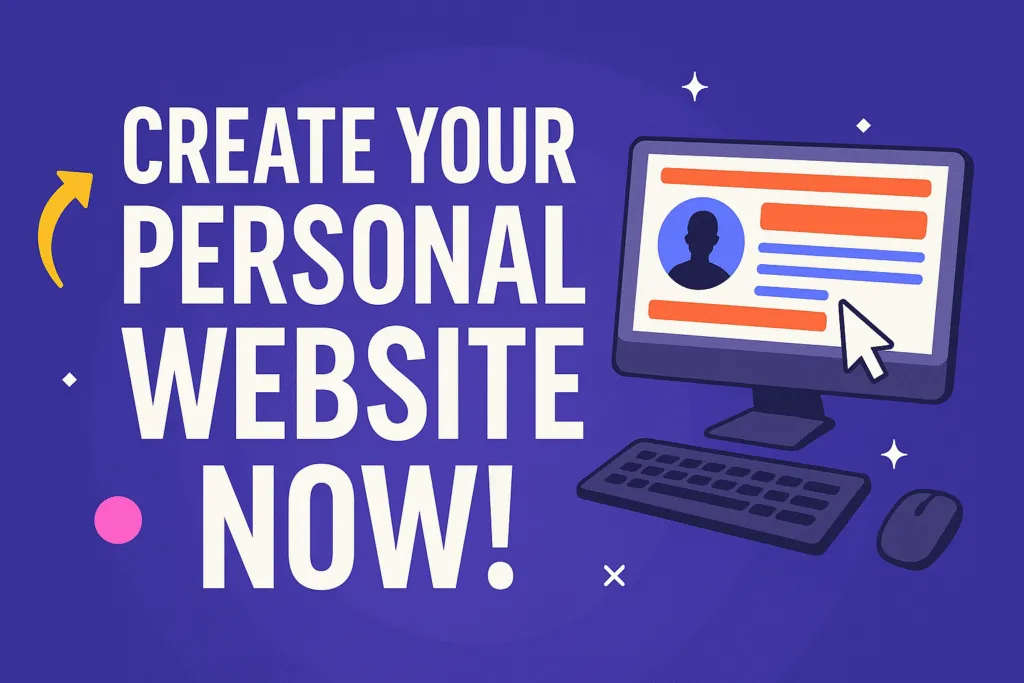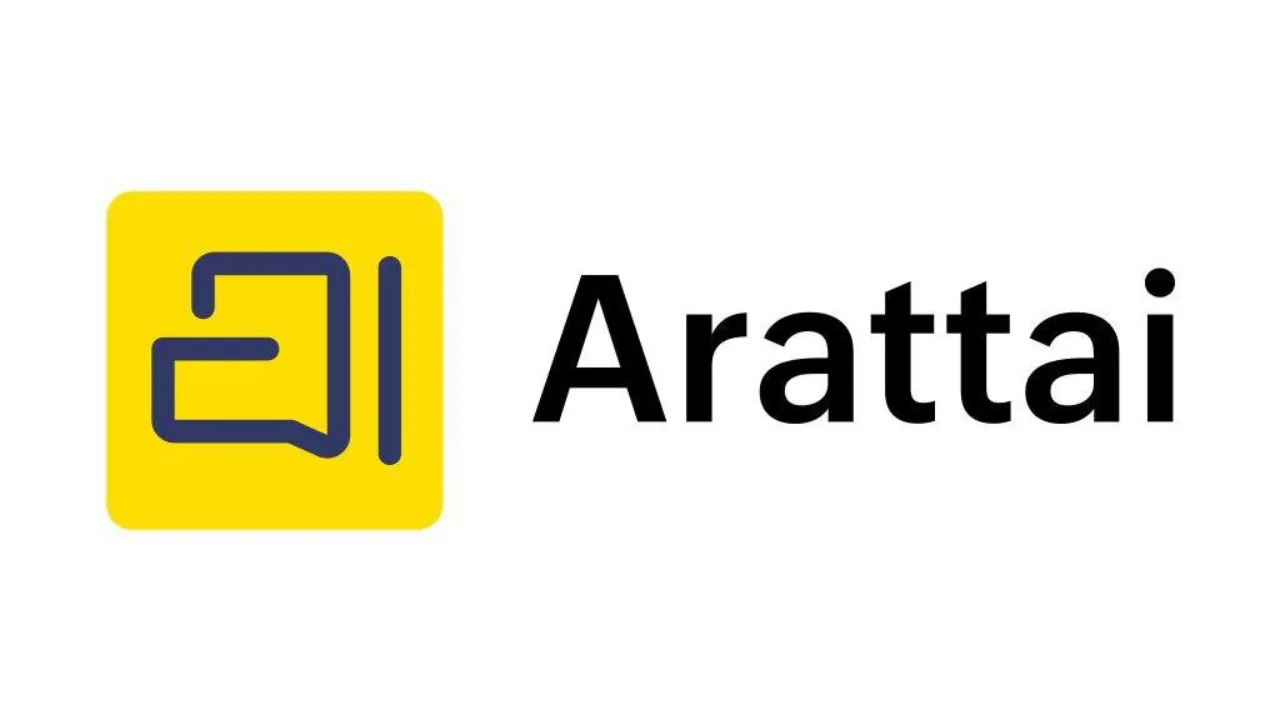Introduction: Why You Need a Personal Website
In today’s digital-first world, having a personal website isn’t just for developers or designers — it’s for everyone who wants to take control of their online identity. Whether you’re a tech blogger, freelancer, student, or job seeker, a personal website gives you a professional edge that social media profiles simply can’t match.
A personal website acts as your digital home. It allows you to showcase your portfolio, share your thoughts, highlight your achievements, and build your personal brand — all in one place. Unlike social platforms where you’re bound by their layout and rules, your own site gives you full control over design, content, and functionality.
More importantly, having your own domain boosts credibility. When someone searches for your name or expertise, a well-structured personal website appears more authoritative than a LinkedIn profile or an Instagram page. It also helps with SEO, making it easier for opportunities to find you online — whether it’s job offers, freelance projects, or collaboration requests.
In short, a personal website isn’t just a resume — it’s your voice, your brand, and your online hub. If you’re serious about standing out in the tech world or any competitive field, building a personal website is one of the smartest moves you can make.
Step 1: Define Your Website’s Purpose and Goals
Before you jump into building your personal website, the first and most crucial step is to define its purpose. Ask yourself: Why am I creating this website? Your answer will guide every design, content, and structural decision going forward. Are you a tech blogger aiming to grow your audience? A developer showcasing your portfolio? Or a freelancer looking to attract clients?
Clearly defining your goals helps you stay focused. If your goal is to share tech insights, then your homepage, blog layout, and navigation should highlight recent articles and make content discovery easy. If you’re building the site to land freelance work, your services, testimonials, and contact form should be front and center.
It’s also important to identify your target audience. Are you speaking to hiring managers, readers, fellow tech enthusiasts, or potential collaborators? Understanding who will visit your site ensures that your tone, design, and content are aligned with their expectations.
Setting specific, actionable goals — like “gain 100 newsletter subscribers in 3 months” or “rank on Google for [your niche] tech keywords” — helps you measure success and make informed improvements over time. Without a clear purpose, even the most beautifully designed website will fall flat. So take the time to plan — your future self will thank you.
Step 2: Choose a Domain Name and Hosting Provider
Once you’ve defined your website’s purpose, the next step is selecting a domain name and a reliable hosting provider. Your domain name is your digital identity — it should be simple, memorable, and aligned with your personal brand. Ideally, choose a name that matches your name or niche, like yourname.com or something relevant like logicmatters.in. Avoid complicated spellings, numbers, or hyphens that make it harder to remember or type.
Make sure to check domain availability using sites like GoDaddy, Namecheap, or Google Domains. If your preferred name is taken, consider slight variations or alternative domain extensions like .in, .net, or .tech.
Next comes hosting — the service that stores your website’s files and makes them accessible online. For beginners or personal brands, shared hosting plans from providers like Hostinger, Bluehost, or SiteGround are budget-friendly and easy to manage. If you expect higher traffic or need faster performance, look into cloud hosting or managed WordPress hosting like HostArmada or Kinsta.
Most hosting providers also offer one-click WordPress installation, SSL certificates, and free business emails — all of which add professionalism to your personal website.
Remember, your domain and hosting form the foundation of your online presence. Choose wisely, because a good domain builds trust, and fast, secure hosting ensures your site stays up and performs well.
Step 3: Select the Right Platform (Code vs CMS)
Choosing the right platform to build your personal website is crucial, and it usually comes down to two options: custom code or a CMS (Content Management System). The right choice depends on your technical skills, budget, and how hands-on you want to be.
If you’re tech-savvy or have web development experience, building your site using HTML, CSS, JavaScript, or frameworks like React or Next.js gives you full control. You can create a truly customized design, optimize performance, and have complete freedom over functionality. However, this route requires regular maintenance, manual updates, and a deeper time investment.
On the other hand, if you prefer simplicity and speed, a CMS like WordPress is ideal. It powers over 40% of websites globally and offers thousands of free themes and plugins. You don’t need to write code — just drag, drop, and publish. Platforms like Wix, Squarespace, and Webflow also fall under this category and are great for visually designing your site without needing technical skills.
For personal blogs, portfolios, or resume sites, WordPress or Webflow is often more than enough. But if you’re a developer building a unique digital product or app-based portfolio, going with custom code may be the better route.
Ultimately, the best platform is the one that fits your goals and comfort level. Whether it’s flexibility through code or ease through CMS, pick a platform that lets you stay focused on content, not complexity.
Step 4: Plan Your Website Structure and Content
Before jumping into design or development, it’s essential to map out your website’s structure and content. A well-planned structure helps visitors navigate easily and ensures that your message comes across clearly. Think of it as creating a blueprint for your digital presence.
Start by listing the key pages your website needs. For a personal website, the essentials usually include: Home, About Me, Portfolio or Work, Blog (if you’re writing), and Contact. Depending on your goals, you might also add Testimonials, Services, Resume, or a Newsletter signup page.
Once your page list is ready, organize it in a logical hierarchy. Your homepage should offer a quick overview and guide users to deeper sections. Keep your top-level menu simple — ideally 4 to 6 items — to avoid overwhelming visitors.
Next, focus on content planning. For each page, jot down what message you want to communicate and the key sections you’ll include. For example, your About page could have a short bio, a photo, and a few personal or professional highlights. Your Portfolio page should showcase your best work with images, brief descriptions, and links if available.
Finally, think about your website’s tone and style. Keep it authentic and aligned with your personality or professional identity. Use clear, concise language and add visuals where they enhance your story.
A thoughtful structure makes your site more user-friendly and improves SEO. The better you plan your content now, the easier the actual building process will be later.
Step 5: Design Your Website Layout (UI/UX Basics)
Designing your website layout is not just about making it look good—it’s about creating an experience that’s smooth, intuitive, and engaging. This is where UI (User Interface) and UX (User Experience) design come into play. A well-designed layout keeps visitors on your site longer and encourages them to explore more.
Start by choosing a clean, easy-to-navigate layout. Your homepage should immediately tell visitors who you are and what you offer. Use whitespace generously to make content easy to read. Stick to 2–3 primary colors and no more than 2 fonts for a consistent and professional look.
Navigation is key in UX. Keep your top menu simple and visible. Use clear labels like “About,” “Work,” or “Contact.” Make sure buttons and links are easy to click, especially on mobile devices.
Think mobile-first. Most users will likely visit your site on a phone, so your layout should be responsive—meaning it adjusts smoothly across devices. Use a mobile-friendly menu, larger tap areas, and legible fonts.
Also, focus on hierarchy. Headlines should stand out, and important sections should come first. Use visuals wisely—profile photos, icons, or screenshots should enhance the message, not distract.
For personal websites, a strong hero section on the homepage can set the tone. It can include a short intro, your photo, and a call to action like “View My Work” or “Contact Me.”
A clean, thoughtful design doesn’t require a graphic design degree—just keep things simple, consistent, and user-centered. By prioritizing good UI/UX, you’re ensuring that visitors not only stay on your site but also remember it.
Step 6: Start Building – HTML, CSS & JavaScript Basics
Once your website layout is planned, it’s time to start building. Even if you’re using a website builder or CMS, having a basic understanding of HTML, CSS, and JavaScript can give you greater control and flexibility.
HTML (HyperText Markup Language) forms the structure of your website. Think of it as the skeleton that defines elements like headings, paragraphs, images, and links. For example, <h1> tags are used for main headings, and <a> tags create links.
Next comes CSS (Cascading Style Sheets), which handles the design side—colors, spacing, fonts, and layout. CSS allows you to make your website visually appealing and consistent. You can style individual pages or apply site-wide styles through an external stylesheet.
JavaScript adds interactivity. Want a button that opens a popup? Or a form that validates user input? That’s where JavaScript comes in. It lets you make your site dynamic and user-friendly without needing to reload pages for every action.
You don’t need to be a pro coder. Start small—learn how to structure a basic HTML page, style it with some CSS, and maybe add a simple JavaScript interaction like a clickable menu or alert. There are plenty of free resources like W3Schools, MDN Web Docs, and CodePen where you can experiment and learn.
Even if you later switch to platforms like WordPress, these coding basics help you troubleshoot issues, customize themes, and understand what’s happening behind the scenes. Starting with the fundamentals of HTML, CSS, and JavaScript is the first real step to turning your personal website idea into a working reality.
Step 7: Make It Responsive and Mobile-Friendly
In today’s mobile-first world, making your personal website responsive is non-negotiable. A responsive website adjusts its layout and content automatically to fit different screen sizes—whether it’s a phone, tablet, or desktop. With most users browsing from mobile devices, this step directly impacts user experience and SEO.
Start by using a responsive layout grid. Frameworks like Bootstrap or CSS Flexbox/Grid make it easier to create flexible designs. Avoid fixed-width elements and use relative units like percentages or em instead of pixels. This ensures that text, images, and containers resize properly across devices.
Use media queries in your CSS to define breakpoints for various screen sizes. This allows you to control how content rearranges on smaller or larger screens. For example, a three-column layout on desktop can become a single-column scroll on mobile for better readability.
Don’t forget to optimize your images. Large or uncompressed files can slow down loading times, especially on slower mobile networks. Use formats like WebP or compressed JPEG/PNG, and always include responsive image tags (srcset) to serve the right size based on screen resolution.
Make buttons and touch elements easy to tap. A good rule is to keep clickable areas at least 48 pixels wide. Also, ensure that text is readable without zooming and that navigation is simple and intuitive.
Finally, test your website across multiple devices and browsers. Tools like Chrome DevTools, BrowserStack, or real device testing can help spot issues early. A mobile-friendly website isn’t just a design upgrade—it’s essential for traffic, engagement, and overall user satisfaction. If you want your personal website to stand out and perform well, responsiveness should be a top priority.
Step 8: Add Essential Pages (Home, About, Contact, etc.)
A professional personal website isn’t complete without a set of core pages that clearly communicate who you are, what you do, and how visitors can connect with you. These essential pages not only organize your content but also build trust with your audience.
Home Page: This is your digital first impression. It should introduce you in a clear, engaging way. Use a headline that captures your purpose, followed by a short description, key highlights (like skills or recent work), and a strong call to action—such as “View My Work” or “Contact Me.”
About Page: People want to know who’s behind the website. Share your story, your mission, and what sets you apart. Keep it human and relatable. A well-written About page builds credibility and connection, especially if you’re a freelancer, creator, or job seeker.
Contact Page: Make it easy for visitors to reach you. Include a simple form, email address, social media links, and optionally a phone number. If relevant, add a Google Map showing your location or business hours. Don’t forget to protect yourself from spam bots with CAPTCHA or form protection tools.
Portfolio or Services Page: If you’re offering services or showcasing work, create a dedicated space. Use images, project details, or client testimonials. Make sure each item clearly explains what you did and the value it provided.
Blog Page (optional): If you plan to share thoughts, tutorials, or updates, a blog helps boost SEO and audience engagement. Keep it organized with categories and easy navigation.
Adding these pages gives your website structure and clarity, guiding visitors to the right information while keeping the user experience smooth. Stick to clean design, consistent branding, and straightforward messaging across all pages.
Step 9: Optimize for SEO and Performance
After building your website’s core structure, it’s time to make sure people can actually find it—and enjoy using it. That’s where SEO and performance optimization come in. A well-optimized website loads fast, ranks higher on search engines like Google, and delivers a better user experience across all devices.
Search Engine Optimization (SEO) starts with your content. Use relevant keywords naturally in your headings, paragraphs, meta titles, and descriptions. Make sure every page has a unique title and SEO-friendly URL (slug). For example, instead of yourname.com/page1, use yourname.com/about-me. Use alt text for all images, write clean HTML code, and add internal links between your pages to help Google crawl your site better.
Install plugins or tools like Rank Math or Yoast SEO (if you’re using WordPress) to guide your on-page SEO. These tools help you add meta tags, generate sitemaps, and integrate social media previews. Also, don’t forget to submit your website to Google Search Console—it helps index your site and monitor performance.
Performance Optimization ensures that your website loads quickly. Compress all images before uploading, use modern formats like WebP, and limit the number of large files and scripts. If you’re using a CMS, avoid installing too many plugins. Use caching tools and a reliable content delivery network (CDN) to serve your site faster to users in different regions.
Finally, test your site’s speed with tools like Google PageSpeed Insights or GTmetrix. Aim for a load time under 3 seconds. Also, check mobile responsiveness—Google now uses mobile-first indexing, so your site must perform well on smartphones and tablets.
Optimizing for SEO and speed isn’t just about rankings—it’s about delivering a seamless experience that makes visitors stay longer, engage more, and come back again.
Step 10: Add Analytics and Tracking Tools
Once your personal website is live, it’s crucial to track how it’s performing. That’s where analytics and tracking tools come in. They help you understand who’s visiting your site, how they found it, what content they like, and where improvements are needed.
The most popular and powerful tool for this is Google Analytics. It’s free and gives you detailed insights about your audience—such as their location, device type, session duration, bounce rate, and the pages they visit. To use it, sign up at analytics.google.com, create a property, and add the tracking ID to your website. If you’re using a CMS like WordPress, plugins like Site Kit or MonsterInsights make this process easier without needing to touch code.
Alongside Google Analytics, use Google Search Console. It shows how your site appears in Google search results, what keywords users type to reach you, and if your pages have any indexing issues. It’s a must for improving your SEO.
If you want even deeper user behavior tracking, tools like Hotjar or Microsoft Clarity can record visitor sessions and show you heatmaps of where users click, scroll, and spend the most time. This helps you improve layout and content placement.
Don’t forget to respect privacy laws like GDPR. Add a cookie consent banner if your website tracks personal data or uses third-party scripts.
Adding analytics might seem technical, but it’s a game-changer. It turns your personal website from a static portfolio into a dynamic platform for learning, improving, and growing your digital presence based on real user data.
Step 11: Test Everything Before Launch
Before your personal website goes live for the world to see, testing is essential. It ensures that everything works as expected and provides a smooth, error-free experience to visitors. Launching without testing can lead to broken pages, slow performance, or even lost opportunities.
Start by checking functionality. Test all your buttons, menus, links, forms (like contact forms or newsletter signups), and any interactive elements. Make sure every link leads to the correct page and that forms submit properly without errors.
Next, test your website on different devices and browsers—like Chrome, Firefox, Safari, and mobile browsers. This ensures your site looks good and functions well across screens and platforms. A responsive website isn’t just a bonus anymore—it’s expected.
Check for loading speed using tools like Google PageSpeed Insights or GTmetrix. A slow website can frustrate users and harm your SEO. Compress images, minimize scripts, and enable caching to boost performance.
You should also verify that your SEO basics are in place: meta titles, descriptions, alt tags for images, proper heading structure, and a clean URL format. These small details make a big difference in how search engines rank your site.
Don’t forget security checks. If you have forms, use reCAPTCHA to prevent spam. Install an SSL certificate (your site should load with HTTPS) to encrypt data and build trust.
Lastly, test your analytics tools—ensure that Google Analytics, Search Console, and other tracking scripts are collecting data correctly.
Taking the time to test everything may seem tedious, but it’s what separates a polished, professional site from an amateur one. It’s your digital first impression—make sure it’s a great one.
Step 12: Go Live and Promote Your Website
Once you’ve built, tested, and refined your personal website, it’s time to go live and let the world see it. But publishing your site is only the beginning—promotion is what brings traffic and visibility.
Start by pointing your domain name to your hosting server if you haven’t already. Most hosting providers offer easy tools for this. Once done, your site will be live to anyone on the internet. Double-check your SSL certificate is working so that your site loads over HTTPS for added security and trust.
Next, submit your website to Google Search Console to ensure it’s indexed by search engines. Upload your XML sitemap to help Google crawl and understand your site structure. Also, verify that your robots.txt file isn’t blocking important content.
Now focus on promotion. Share your website on all your social media platforms—LinkedIn, Twitter (X), Instagram, and Facebook. Let friends, colleagues, and your professional network know your site is live. Add your website link to your social media bios and email signature to continuously drive traffic.
Consider writing a blog post or article on your site announcing its launch, detailing your goals, and encouraging visitors to explore. Use relevant keywords to help it rank in search engines.
If you’re active in any online communities (like Reddit, Quora, or tech forums), include your site link where relevant—but avoid spammy behavior. You can also join blogging directories, submit your site to portfolio sites, or use guest blogging to gain backlinks.
Going live is an exciting milestone, but consistent promotion is what truly builds reach and authority. Keep sharing your content, updating your site, and interacting with your audience to grow over time.
Bonus Tips: Tools, Resources & Maintenance Advice
Creating your personal website is just the beginning. To keep it running smoothly, looking great, and ranking well, you need the right tools, reliable resources, and regular maintenance. Here are some essential tips to help you stay on top of it all.
Must-Have Tools
Use Google Search Console and Google Analytics to monitor performance and user behavior. For SEO, tools like Rank Math, Yoast SEO, or Ubersuggest can help optimize your pages. If you’re using WordPress, plugins like WP Super Cache and Smush improve speed and image performance.
Free Resource Platforms
For stock photos, try Unsplash, Pexels, or Pixabay. For design, use Canva or Figma to create banners and social share graphics. If you’re working with code, MDN Web Docs, W3Schools, and Stack Overflow are goldmines of helpful information.
Regular Maintenance Checklist
Update your CMS, themes, and plugins regularly to avoid security vulnerabilities. Take weekly backups using plugins like UpdraftPlus or through your hosting panel. Test your forms and links monthly to ensure everything works properly. Also, keep an eye on your site’s loading speed and fix broken images or scripts.
Content Updates
A stagnant website doesn’t rank well. Update your portfolio, blog, or about section at least once a month. Add testimonials, case studies, or new achievements to keep your site fresh and engaging.
Security Tips
Install an SSL certificate and use security plugins like Wordfence (WordPress) to protect your site. Enable two-factor authentication for your login dashboard if available.
Maintaining a personal website requires ongoing attention, but with the right tools and habits, it becomes an easy part of your digital routine—and keeps your online presence strong and professional.
Conclusion: Build, Learn, Improve
Creating your personal website isn’t just a one-time project—it’s a continuous journey of growth. From defining your goals to going live, every step helps you better understand how the internet works and how to present yourself effectively. Whether you’re a student, professional, or entrepreneur, your website becomes your digital identity—a place that reflects your skills, personality, and goals.
The real value lies not just in building the site but in learning through the process. You’ll explore design basics, experiment with SEO strategies, troubleshoot bugs, and improve your writing—all of which sharpen your digital skillset. Over time, this website evolves with you, becoming stronger as you learn more and improve it regularly.
Don’t wait for perfection. Start simple, stay consistent, and upgrade along the way. Your first version doesn’t have to be flawless—it just needs to exist. You can always redesign, restructure, or rebrand it later. What matters is that you start building now, learn at every step, and improve as you grow. Your future self will thank you.
Also Read: Cloud Computing 2025: Simple Guide & Powerful Benefits
FAQs – About Building a Personal Website
1. Do I need coding skills to build a personal website?
No, many platforms like WordPress, Wix, and Squarespace allow you to build professional websites without any coding. But if you know basic HTML, CSS, or JavaScript, it opens up more customization.
2. How much does it cost to create a personal website?
A simple website may cost between ₹1,000 to ₹5,000 annually for domain and hosting. Some platforms also offer free versions, but they usually come with limitations and ads.
3. Which platform is best for beginners?
For ease of use and flexibility, WordPress.org is a great choice. Wix and Squarespace are also beginner-friendly with drag-and-drop interfaces, especially if you don’t want to manage hosting separately.
4. What should I include on my personal website?
Your site should include a homepage, about me section, contact page, and if relevant, a portfolio or blog. Also, include social media links, a downloadable resume, or testimonials.
5. Is a personal website useful for job seekers or freelancers?
Absolutely. A personal website works like a digital portfolio or resume, helping you stand out and showcase your work, skills, and experience more professionally than just a LinkedIn profile.













